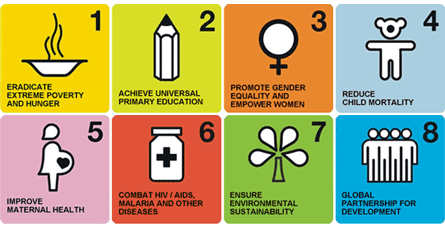Microfinance and the Millennium Development Goals
May 20, 2009
 Microfinance, while not the cure-all tool for development, is a very powerful tool for poverty reduction in the developing world. We’ve all heard the effect it has on poverty as portrayed in numerous academic studies and from sources like Muhammad Yunus. Because of my infatuation with microfinance I started wondering what other impact microfinance has had on development issues such as inequality. After a quick search on UC Berkeley’s academic journal search tool I only found one (one?!!) article which even mentioned inequality. This was evidence to me that microfinance is still in its infancy as an academic subject.
Microfinance, while not the cure-all tool for development, is a very powerful tool for poverty reduction in the developing world. We’ve all heard the effect it has on poverty as portrayed in numerous academic studies and from sources like Muhammad Yunus. Because of my infatuation with microfinance I started wondering what other impact microfinance has had on development issues such as inequality. After a quick search on UC Berkeley’s academic journal search tool I only found one (one?!!) article which even mentioned inequality. This was evidence to me that microfinance is still in its infancy as an academic subject.
Prior to becoming a Kiva Fellow I decided that I wanted to go back to graduate school and study economic development with an emphasis in microfinance, if at all possible. Because I discovered the lack of scholarly attention towards microfinance and its impact towards other development issues I decided that I wanted to study what impact microfinance has on all aspects to the UN’s Millennium Development Goals besides just poverty reduction.
The Millennium Development Goals are eight international development goals that 192 United Nations member states have agreed to achieve by the year 2015. While it is very debatable that the goals can be achieved by that date, they are nonetheless goals worth fighting towards for a long time to come. The eight goals (which have more specifics than shown below) are as follows:
1) Eradicate extreme poverty and hunger. 2) Achieve universal primary education. 3) Promote gender equality and empower women. 4) Reduce child mortality. 5) Improve maternal health. 6) Combat HIV/Aids, malaria, and other diseases. 7) Ensure environmental sustainability. 8) Develop a global partnership for development.
My question for these goals is simple: does microfinance have a significant impact on any of these goals besides poverty reduction? My theory, as of now, is that yes it does impact at least five, maybe even seven of these goals; however I need to run statistical models to test the significance. In short I believe that since most clients are women, goal 3 has a major impact and since a goal of microfinance is increasing credit to hopefully increase family income, the other goals will be affected as well. Think about it like this: extra money means maybe another child will get to continue their education, or there is now money available to afford the medicines required to fight a child’s malaria bout to keep them alive past the age of five (goals 4 and 6), etc., etc…
As an anecdotal case, here in Vietnam with my MFI SEDA, I know that the vast majority of borrowers are female. According to the women I have interviewed, the majority have seen an increase in their standard of living and income (whether this is due to a real increase in income or income simply mirroring inflation is another topic that needs to be studied) and many who still have school age children use their extra income to pay for their kids tuition fees and hope that their children will be able to go to university and further increase their standards of living, especially for eldest sons (who take care of the parents when they get older!). Furthermore, many of the women now have extra income to also buy medicines if their children become sick. Just from my interactions with the borrowers here, I see a potential impact going beyond just poverty reduction…I see Millennium Goals 1-6 being affected. Thus there is reason for further study into this impact!
To learn more about the Millennium Development Goals, please check out the MDG Wikipedia page. If you’re interested in lending to SEDA borrowers to help them have an impact on the Millennium Development Goals, please check out SEDA’s fundraising page!
/>













